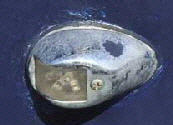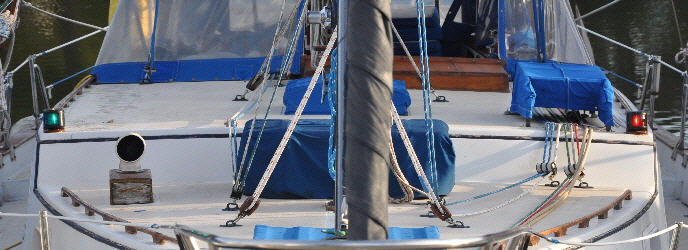
 Britannia was originally fitted with navigation lights so tiny I wouldn't fit them on a dinghy! They were the tear-drop style, mounted on the hull below the toe-rail only 3’ feet above the waterline, and could easily be obscured in even a moderate sea. Add to this the tiny 10-watt festoon bulbs and the boat of her size had very ineffective navigation lights.
Britannia was originally fitted with navigation lights so tiny I wouldn't fit them on a dinghy! They were the tear-drop style, mounted on the hull below the toe-rail only 3’ feet above the waterline, and could easily be obscured in even a moderate sea. Add to this the tiny 10-watt festoon bulbs and the boat of her size had very ineffective navigation lights.
 A set of three individual Aqua-signal series 41 lamps that have Fresnel lenses with a minimum visibility of two nautical miles were fitted. They are mounted at each corner of the saloon coachroof, this being the highest point on the deck and unobstructed in all directions. They are mounted on solid teak bases and chamfered allowing the lamps to sit vertically.
A set of three individual Aqua-signal series 41 lamps that have Fresnel lenses with a minimum visibility of two nautical miles were fitted. They are mounted at each corner of the saloon coachroof, this being the highest point on the deck and unobstructed in all directions. They are mounted on solid teak bases and chamfered allowing the lamps to sit vertically.
 There is independent wiring to each lamp and the 25-watt incandescent bulbs were replaced with LED bulbs. The HQRP BAY15d LED bulbs consume less than three watts at 12-volts and are better luminosity than the bulbs supplied with the lamps.
There is independent wiring to each lamp and the 25-watt incandescent bulbs were replaced with LED bulbs. The HQRP BAY15d LED bulbs consume less than three watts at 12-volts and are better luminosity than the bulbs supplied with the lamps.
 A photograph of the comparison with the new lamp with its LED bulb is astonishing and difficult to believe that the new lamps use much less power than the old 25-watt bulbs.
A photograph of the comparison with the new lamp with its LED bulb is astonishing and difficult to believe that the new lamps use much less power than the old 25-watt bulbs.
